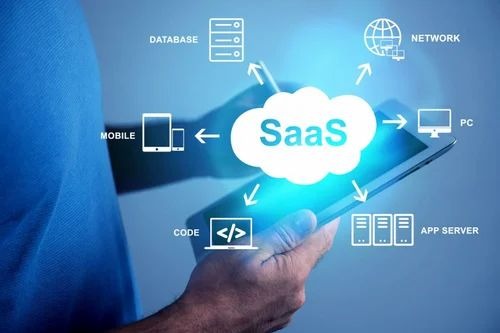
What is SaaS? Everything You Need to Know About Software as a Service
In late 2024, SaaS writing became a big deal. Everyone was talking about it and while it is a profitable niche, there are still many questions about the topic.
What is SaaS? What companies use it, and how do they make money? Most importantly, how can writers break into the SaaS industry?
In this article, I'll answer these questions and guide you into understanding what SaaS means.
What is SaaS?
SaaS stands for Software As A Service, and is a method of accessing software applications over the internet rather than downloading and installing them on devices.
A perfect example is Slack. While they have the application which can be installed on your device, they also have the web version which is easily accessible through the internet. That web version which you can sign into and access anytime, is an example of a SaaS product.
Examples of SaaS products are:
1. Netflix: A software service for easy movie download and streaming.
2. Zoom: A video conferencing software for meetings without the stress of complicated installations.
3. Canva: An online design tool that can be accessed through the internet, along with a cloud storage option.
Most of these SaaS tools have apps that can be downloaded. But, the key difference lies in their accessibility options.
While traditional software apps require a one time download and installation on a device, SaaS tools are cloud-based meaning they can be accessed multiple times from any device with an internet connection.
Also, the web versions usually have more features than the apps which is a big advantage in SaaS tools. So, you don't have to deal with app purchases when you can just subscribe on the net and access it anytime.
How does SaaS work?
In simple terms, SaaS tools are hosted on cloud servers and users simply click the website link, sign up and log into the service. No downloads necessary.
Most SaaS products work with subscription-based pricing models, where users pay monthly or yearly fees to gain access. Some common models include:
1. Freemium: Free basic features with paid premium upgrades e.g Zoom, Grammarly, Canva.
2. Flat-Rate Subscription: Users pay monthly or yearly fees to gain access e.g Netflix.
3. Usage-Based Pricing: Payment plans are dependent on how much the user consumes services like storage e.g Amazon Web Services.
These recurring charges allow the SaaS companies to maintain the software, upgrade their services and provide privacy protection for their users.
Why SaaS?
With the way technology is rising, there is no doubt that SaaS products have a lot of users, and here is why.
1. Accessibility: Users can access SaaS tools from anywhere with an internet connection.
2. Cost effective: Most SaaS tools can be used without expensive upfront purchases. Instead, users pay for only what they need or use the free versions.
3. Automatic Updates: Unlike traditional software that requires manual updates, SaaS tools update automatically in the cloud and seamlessly incorporate the new features.
4. Easy To Scale Up: With SaaS tools, companies can easily build up their services based on demand. Also, the cost of building a traditional software app is a lot more than creating and uploading a website.
Top SaaS Tools for Individuals and Businesses
SaaS tools are used across major industries, and here are some of them:
1. Productivity Tools: Google Workspace, Notion, Trello
2. E-commerce Platforms: Jumia, Konga, Shopify, BigCommerce
3. Marketing & Sales Software: HubSpot, Mailchimp, Hootsuite
4. Cloud Storage & Collaboration: Dropbox, Slack, Microsoft Drive
5. Finance & Accounting: QuickBooks, FreshBooks
What is SaaS Writing?
Freelance writers are always in search of goldmines, and SaaS writing is one of them - especially with the rise of tech startups and AI-based models. Fortunately, most companies need skilled writers to explain their products and services to users.
SaaS writing is all about creating content that informs, educates, and sells SaaS products to potential users. Usually SaaS products are often technical, so the goal is for writers to break them down into simple, relatable content that helps users understand why they need the software and how to use it effectively.
Writing in this niche comes in a lot of forms, but the most popular and necessary are:
1. Articles & Blog Posts: These are SEO-optimized contents that explain the features and benefits of using an SaaS product.
Example: 5 Ways MailChimp Can Boost Your Email Marketing Strategies.
2. Product Descriptions & Landing Pages: These come in web pages and explain what the SaaS product is and why it is valuable. Usually, user reviews are a huge part of this.
3. User Guides & Tutorials: These offer step-by-step content to help users understand how to use the product for optimum benefits.
4. Email Newsletters: Here, writers make use of engaging emails to promote a new service, keep users updated about new features or encourage them to upgrade to subscription based plans.
For writers who want to delve into SaaS writing, understanding the product and target audience is crucial. Going into this niche can be very similar to copywriting, so strong storytelling skills are necessary as well as the ability to explain complex ideas in simple terms.
*****
For the past one year, SaaS products have transformed and taken industry sectors to success. From offering flexibility and affordability to the ease of use, these software services have proven to be very helpful to individuals and businesses alike.
This is enough proof that the SaaS industry will only continue to grow, and as writers look to keep up with the trend, it is a profitable niche to venture into.
The future of tech is SaaS-driven, and staying ahead in this space is a great way to build a successful writing career.
Post a comment